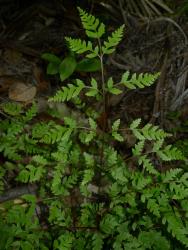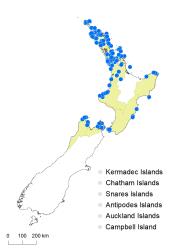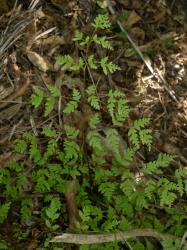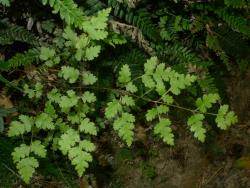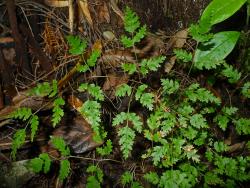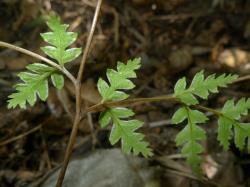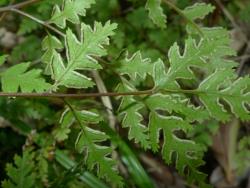- ≡ Pteris macilenta var. saxatilis Carse, Trans. & Proc. New Zealand Inst. 51: 95 (1919)
Rhizomes erect, scaly. Rhizome scales narrowly ovate, 3–5 mm long, 0.4–0.9 mm wide, pale brown, concolorous, entire. Fronds 145–700 mm long. Stipes 40–235 mm long, red-brown proximally, yellow-brown or chestnut-brown distally, with a few scattered pale brown scales up to 4 mm long and 1 mm wide, especially proximally. Rachises chestnut-brown or yellow-brown, narrowly winged only in distal half, bearing scattered scales. Laminae 2-pinnate-pinnatifid to 3-pinnate-pinnatifid, 100–500 mm long, 35–300 mm wide, ovate to broadly ovate, mid-green adaxially, pale green abaxially, herbaceous, glabrous or with scattered scales on the costae. Primary pinnae in 3–9 pairs below pinnatifid apex, widely spaced, not overlapping; the longest at or near base, 40–350 mm long, 16–100 mm wide, narrowly ovate to ovate, straight; pinna apices acute to acuminate, bases long-stalked. Longest secondary pinnae 12–85 mm long, 6–35 mm wide, ovate to elliptic, widely spaced, sub-opposite; apices acute, bases stalked; basal basiscopic secondary pinna on each primary pinna not markedly longer than others. Longest tertiary segments 4–24 mm long, 2–12 mm wide, ovate or elliptic or oblong; apices acute, margins entire to deeply indented, bases adnate or short-stalked. Veins anastomosing. Sori elongated along margins of the ultimate segments. Mean exospore size 32–37 μm in diameter.
Pteris saxatilis is distinguished by its erect rhizome, 2-pinnate to 3-pinnate-pinnatifid laminae, anastomosing veins, widely spaced pinnae, herbaceous ultimate segments, and secondary pinnae that are mostly stalked on the lowermost primary pinnae. It is very similar to P. macilenta but is generally a smaller plant with a more delicate lamina and more widely spaced pinnae. The secondary pinnae on the lower primary pinnae are more obviously sub-opposite rather than alternate. It also has smaller spores than those in P. macilenta (exospores 32–37 μm, cf. 41–46 μm in diameter).
Plants of P. saxatilis are believed to hybridise with both P. macilenta and P. carsei, making identification difficult in areas where the species overlap.
North Island: Northland, Auckland, Gisborne, Taranaki, Southern North Island.
South Island: Western Nelson, Sounds-Nelson.
Altitudinal range: 0–360 m.
Pteris saxatilis occurs in coastal and lowland sites from Te Paki south to East Cape and the north Taranaki coast, with outlying populations in Hawke’s Bay, Wellington and the north coast of the South Island. It is absent from the central North Island and all the main mountain ranges. It grows from near sea level, reaching over 360 m on Mt Manaia, Whangārei Heads.
Pteris saxatilis is a terrestrial fern that grows under coastal forest and scrub, and in drier kauri, broadleaved forest, and mānuka and kānuka scrub. It is found on coastal cliffs, on creek banks, in damp gullies, on clay and grassy banks, and amongst rocks and scree, occurring on both greywacke and limestone rock.
Pteris saxatilis is believed to hybridise with both P. carsei and P. macilenta, especially in coastal areas of Northland and Auckland. Extensive hybrid swarms with P. carsei are known in several localities (see suites of material in AK). Spores of putative hybrids are sometimes abnormal in appearance, but are not as easy to detect as in genera such as Asplenium or Polystichum. There may be some degree of fertility in hybrids between P. saxatilis and P. carsei, and back-crosses to both parents could be possible. Hybrids between P. saxatilis and P. macilenta are less common, but are more likely to have aborted spores because of the difference in chromosome number (e.g. AK 353155, 353276, 353488). Braggins (1975) created artificial hybrids between the diploid species, P. saxatilis and P. carsei, and it is likely on morphological grounds that P. macilenta is an allotetraploid derivative of wild hybrids between these two diploid species. However, experimental evidence for this is lacking, and all three species have very similar chloroplast DNA sequences indicating a close relationship (Bouma et al. 2010).
2n = 58 (Walker 1962).



